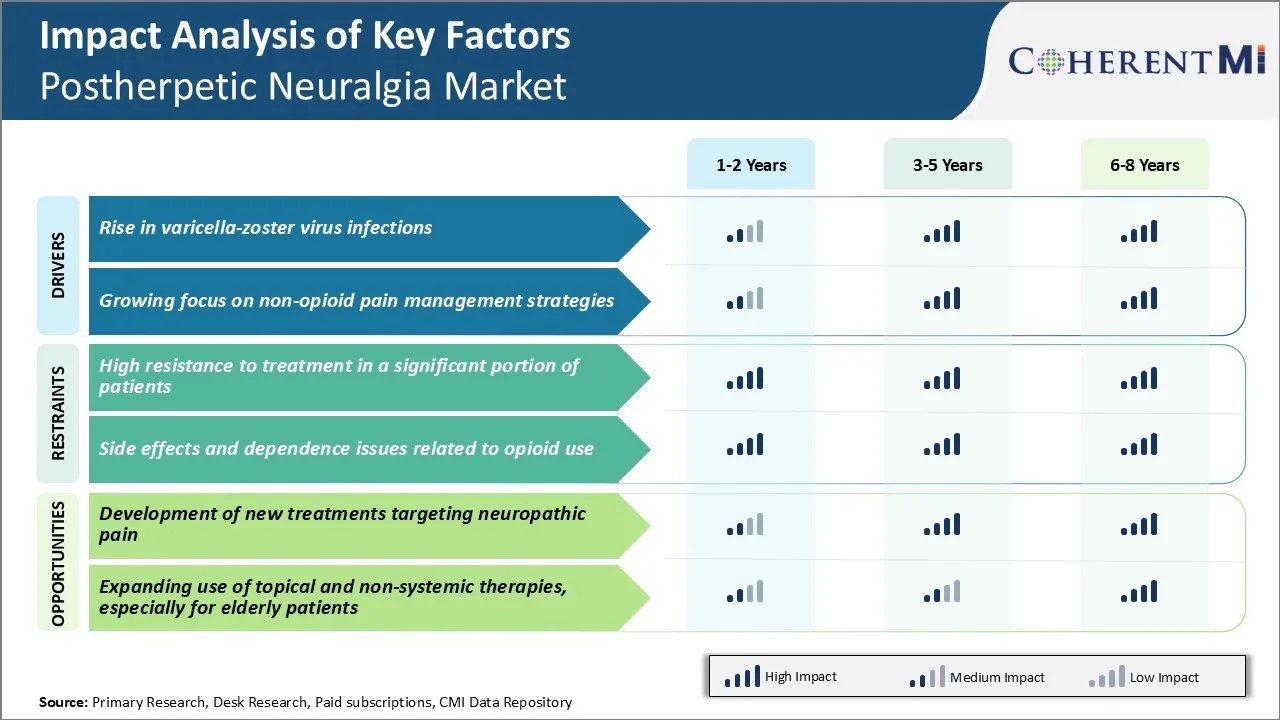Postherpetic Neuralgia Market Trends
Market Driver - Rise in Varicella-Zoster Virus Infections
Overall number of zoster virus infections has been rising in recent years due to aging populations. It is happening also because primary chickenpox infections are declining in the developed world due to widespread vaccination programs. With reduced natural boosting of immunity, more people are at risk of shingles as they get older.
While chickenpox vaccination has been highly successful in reducing the disease burden, it may be inadvertently contributing to increasing shingles cases in the long run. Since thevaricella virus remains latent lifelong after primary infection, increased shingles cases will continue emerging over the coming decades. This rising trend of zoster infections is expanding the at-risk population for developing postherpetic neuralgia.
More cases of acute zoster pain are expected to evolve into the chronic and often debilitating stage of postherpetic neuralgia. This is expected to bolster growth of the postherpetic neuralgia market in the coming years.
Market Driver - Growing Focus on Non-opioid Pain Management Strategies
Ongoing epidemic of opioid abuse and overdoses has intensified scrutiny on prolonged use of these drugs even for legitimate medical purposes. Regulators and healthcare providers are seeking safer alternatives for chronic non-cancer pain conditions like postherpetic neuralgia. This has created opportunities for new treatments targeting the specific pathophysiology of neuropathic pain.
Drug makers are exploring disease-modifying mechanisms beyond symptomatic relief. Some candidate therapies aim to prevent or reverse nerve damage during the acute zoster infection stage before pain pathways become established. Non-opioid topicals, patches and creams are being studied for localized treatment.
Research into neuromodulation techniques like TENS, acupuncture and cognitive behavioral therapy is ongoing. Multimodal strategies combining pharmacological and non-pharmacological components also hold promise. Overall, the drive towards minimizing opioid exposure where possible is directing innovation towards tackling the root cause of postherpetic neuralgia. This shift in clinical approach presents sizable commercial opportunities in the postherpetic neuralgia market.

Market Challenge - High Resistance to Treatment in a Significant Portion of Patients
One of the major challenges faced in the postherpetic neuralgia market is the high resistance to treatment in a significant portion of patients affected by the condition. Currently available treatment options include antiviral medications, antidepressants, gabapentin, and lidocaine patches. However, research shows that nearly 30-40% of patients experience little to no pain relief even after trying multiple treatment lines.
The pathophysiology of neuropathic pain in postherpetic neuralgia patients is still not fully understood. This has made it difficult for physicians to determine the most effective treatment regimen for individual patients.
The differing efficacy of existing treatments across patients points to the need for more targeted therapies that can address the underlying reasons for drug resistance in recalcitrant patients. This resistance to available medications poses a major hurdle in effectively managing pain and reducing the health burden of postherpetic neuralgia.
Market Opportunity - Development of New Treatments Targeting Neuropathic Pain
One of the key opportunities in the postherpetic neuralgia market lies in the development of new treatments that can better target the underlying mechanisms of neuropathic pain. Currently, none of the medications available are specifically designed to act on neuropathic pain pathways.
Researchers are actively exploring new compounds and molecular targets that can more effectively interrupt pain signaling in the peripheral and central nervous system. Some potential areas being studied include sodium channel blockers, N-methyl-D-aspartate receptor antagonists, alpha-2 delta ligands, serotonin-norepinephrine reuptake inhibitors, and nerve growth factor inhibitors.
Clinical success of any new treatments in phase 2 and 3 trials could enable better management of postherpetic neuralgia symptoms and open up new revenue streams. Moreover, novel delivery methods such as patches, implants and stem cell therapies also offer scope for minimally invasive pain relief. Effectively targeting neuropathic pain holds out the promise of transforming postherpetic neuralgia management over the coming years.